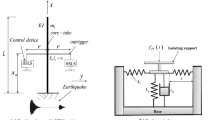Abstract
Purpose
To understand the effect of Ritz vectors on the random seismic response of non-uniform cantilever beam, the following works are performed:
Method
Firstly, the equation of random seismic response of non-uniform cantilever beam based on Hamilton theory is presented. The solution is derived using the combined classical Ritz and pseudo-excitation method. Secondly, by considering the principle of virtual displacement, the pertinent function can be obtained from the characteristics of pseudo-excitation method. The mode of analysis is transformed from structural stationary random to structural harmonic response. Finally, the results of the analysis of the cantilever beam samples of different Ritz vectors are presented. The functional extremum corresponding to increasing Ritz vectors is compared.
Results and conclusions
It can be concluded based on the result findings that the Ritz vectors, which satisfy both the geometrical and the natural boundary conditions, do not necessarily lead to accurate results. It is, therefore, recommended that the extreme value of the function for the whole system should be considered as an evaluation criterion for the Ritz vectors.












Similar content being viewed by others
References
Timoshenko S (1937) Vibration problems in engineering, 2nd edn. D. Van Nostrand Company Inc, New York
Dym CL, Shames IH (1973) Solid mechanics: a variational approach. McGraw-Hill Book Company Inc, New York
Weichang Q (1980) Variational method and finite element method. Beijing Science Press, Beijing
Thomson WT et al (1998) Theory of vibrations with applications, 5th edn. Pearson Education Inc, Hoboken
Chopra AK (2005) Dynamics of structure: theory and application to earthquake engineering, 2nd edn. Tsinghua University Press, Beijing
Gupta A, Rustogi SK, Gupta AK (1999) Ritz vector approach for evaluating in cabinet response spectra. Nucl Eng Des 190:255–272
Gupta A, Yang J (2002) Modified Ritz vector approach for dynamic properties of electrical cabinets and control panels. Nucl Eng Des 217:49–62
Laura PAA, Gutierrezi RH, Rossi RE (1996) Free vibrations of beams of bilinearly varying thickness. Ocean Eng 23(I):1–6
Zhou D, Cheung YK (2000) The free vibration of a type of tapered beams. Comput Methods Appl Mech Eng 188:203–216
Zhou B, Han X, Tan S (2014) A simplified computational method for random seismic responses of a jacket platform. Ocean Eng 82:85–90
Zhou B, Guo W, Han X, Tan S (2016) Random seismic response analysis of jacket structure with Timoshenko’s beam theory. Ships Offshore Struct 11:438–444
Datta N, Thekinen JD (2016) A Rayleigh-Ritz based approach to characterize the vertical vibration of non-uniform hull girder. Ocean Eng 125:113–123
Zarei H, Fallah M, Bisadi H, Daneshmehr AR, Minak G (2017) Multiple impact response of temperature-dependent carbon nanotube-reinforced composite (CNTRC) plates with general boundary conditions. Compos B Eng 113:206–216
Sohn H, Law KH (2000) Application of load-dependent Ritz vectors to Bayesian probabilistic damage detection. Probab Eng Mech 15:139–153
Skafte Anders, Kristoffersen Julie, Vestermark Jonas, TygeTygesen Ulf, Brincker Rune (2017) Experimental study of strain prediction on wave induced structures using modal decomposition and quasi static Ritz vectors. Eng Struct 136:261–276
Wilson EL, Eduardo PB (1986) Use of special Ritz vectors in dynamic sub-structure analysis. J Struct Eng 112(8):1944–1954
Klerk DD, Rixen DJ, Voormeeren SN (2008) General framework for dynamic sub-structuring: history, review and classification of techniques. AIAA J 46(5):1169–1181
Amabili M, Garziera R (1999) A technique for the systematic choice of admissible functions in the Rayleigh–Ritz method. J Sound Vib 224(3):519–539
Auciello NM, Ercolano A (2004) A general solution for dynamic response of axially loaded non-uniform Timoshenko beams. Int J Solids Struct 41:4861–4874
Lin J, Zhang YH (2004) Pseudo excitation method of random vibration. Science Press, Beijing (in Chinese)
Lin J, Zhang YH, Zhao Y (2011) Pseudo excitation method and some recent developments. Proc Eng 14:2453–2458
Acknowledgements
The research work presented in this paper is supported by “the Fundamental Research Funds for the Central Universities”.
Author information
Authors and Affiliations
Corresponding author
Additional information
Publisher's Note
Springer Nature remains neutral with regard to jurisdictional claims in published maps and institutional affiliations.
Rights and permissions
About this article
Cite this article
Han, X., Zhou, B., Gho, WM. et al. Effect of Ritz Vectors on Random Seismic Response of Cantilever Beam. J. Vib. Eng. Technol. 7, 321–333 (2019). https://doi.org/10.1007/s42417-019-00121-4
Received:
Accepted:
Published:
Issue Date:
DOI: https://doi.org/10.1007/s42417-019-00121-4




